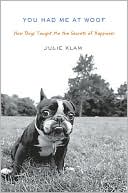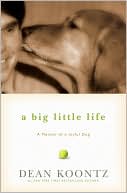The Intelligence of Dogs: A Guide to the Thoughts, Emotions, and Inner Lives of Our Canine Companions
How Smart Is Your Dog?\ If you've ever wondered what is really going on inside your dog's head, here is your chance to find out. In this revised and updated version of this perennially popular book, psychologist and prizewinning trainer Stanley Coren provides a startling view of the intelligence of our oldest and closest animal companions.\ Do dogs really think? Are they conscious in the same way humans are? What is the nature of canine memory? Can dogs communicate with us -- and, if so, how...
Search in google:
Preface to the Revised EditionWhen the first edition of this book came out in 1994, I was trying to address a problem that most of the books that were being published about dogs at the time did not. There were only veterinary guides, obedience-training books, and breed books that were not concerned about how dogs think. These books had other purposes and thus did not try to describe dogs' intelligence or mental capacity. It was my hope that The Intelligence of Dogs would help to fill that gap in the literature by giving readers a picture of how a dog's mind works.As a psychologist, dog trainer, and avowed dog lover, I set out to describe the mental abilities that are present in every dog. I also went one step further — namely, to explore how various breeds differ in their capacities and behaviors. Before I could do this, though, a bit of groundwork was in order. I began by looking at the origins of dogs, because any animal's mental ability is shaped and limited by its biological makeup and the forces of evolution that have worked on it. Then I briefly examined how scientists have viewed dogs' minds and detailed some of the controversy about the nature of the canine mind and consciousness. Finally, I looked at the various types of dog intelligence and described how dog owners could actually measure their own dog's abilities. While I hoped to make it clear that no breed of dog is without merit or purpose, I also pointed out that not all dog breeds are created equal in terms of their cleverness and mental skills.The enthusiastic reception of the first edition of this book indicated that many people wanted andneeded this kind of information, and since then some other competent dog experts, researchers, and writers have followed in my footsteps by trying to provide information about the thought processes and abilities of dogs. Each has added to our knowledge of the canine mind in his or her own way.Since The Intelligence of Dogs was first published, a lot of new research has been completed, and it has helped us to better understand the behavior and origins of our dogs. This revised edition therefore became necessary in order to update the original material with some of these new insights. Included in this revision is new material about the wild ancestors of dogs, how dogs came to be domesticated, their communication, thinking, and problem-solving abilities, and their personalities. I have even included some new techniques for expanding your dog's mental capacity — in effect, how to make your dog smarter. Finally, the ranking of working and obedience intelligence has been expanded, and now includes 140 dog breeds.This book would not have been possible without the assistance of many people. Most particularly, I must acknowledge the help of 208 dog obedience judges. This is more than half the total number of these specialists in all of North America. Each of the 208 took the time to fill in a very complex, involved survey. The completed surveys provided me with much of the information I give in the book. Many of these busy experts also took it upon themselves to independently provide me with extensive written insights into the minds of dogs. More than two dozen of these trained observers of dog behavior also allowed me to interview them in depth, and most of these interviews lasted several hours. All this helped create a picture of the working intelligence of dogs. In addition to the dog obedience judges, sixty-three small animal veterinarians answered my questions about the personalities of dogs and some of the quirks of individual breeds. Next, fourteen specialists in guard and protection dogs provided data and observations about dogs that have or lack the qualities of interest to their area of expertise. Since the first edition of this book, I have also had numerous discussions and interviews with additional scientists who study animal behavior and they have helped to bring me up to date with new information from research done in their laboratories. An added bonus is that countless dog obedience competitors and just plain family dog owners have spoken with me or written letters and e-mails to tell me about their special stories and experiences with their own pet and companion dogs.A very personal acknowledgment goes to the Vancouver Dog Obedience Club, to both its instructors and members, who have served not only as valuable resources but also as good friends over our long period of association. Finally, I would like to thank my wife, Joan, who read and commented on this manuscript but, more important, has put up with me and a house full of dogs, with only occasional lapses into hysteria. Her love and support are a constant comfort to me. — Stanley Coren Publishers Weekly Psychologist and trainer Coren studies the psychological makeup of dogs in an attempt to answer many questions about canine emotions and intelligence. (Apr.)
Preface to the Revised Edition\ When the first edition of this book came out in 1994, I was trying to address a problem that most of the books that were being published about dogs at the time did not. There were only veterinary guides, obedience-training books, and breed books that were not concerned about how dogs think. These books had other purposes and thus did not try to describe dogs' intelligence or mental capacity. It was my hope that The Intelligence of Dogs would help to fill that gap in the literature by giving readers a picture of how a dog's mind works.\ As a psychologist, dog trainer, and avowed dog lover, I set out to describe the mental abilities that are present in every dog. I also went one step further — namely, to explore how various breeds differ in their capacities and behaviors. Before I could do this, though, a bit of groundwork was in order. I began by looking at the origins of dogs, because any animal's mental ability is shaped and limited by its biological makeup and the forces of evolution that have worked on it. Then I briefly examined how scientists have viewed dogs' minds and detailed some of the controversy about the nature of the canine mind and consciousness. Finally, I looked at the various types of dog intelligence and described how dog owners could actually measure their own dog's abilities. While I hoped to make it clear that no breed of dog is without merit or purpose, I also pointed out that not all dog breeds are created equal in terms of their cleverness and mental skills.\ The enthusiastic reception of the first edition of this book indicated that many people wanted and needed this kind of information, and since then some other competent dog experts, researchers, and writers have followed in my footsteps by trying to provide information about the thought processes and abilities of dogs. Each has added to our knowledge of the canine mind in his or her own way.\ Since The Intelligence of Dogs was first published, a lot of new research has been completed, and it has helped us to better understand the behavior and origins of our dogs. This revised edition therefore became necessary in order to update the original material with some of these new insights. Included in this revision is new material about the wild ancestors of dogs, how dogs came to be domesticated, their communication, thinking, and problem-solving abilities, and their personalities. I have even included some new techniques for expanding your dog's mental capacity — in effect, how to make your dog smarter. Finally, the ranking of working and obedience intelligence has been expanded, and now includes 140 dog breeds.\ This book would not have been possible without the assistance of many people. Most particularly, I must acknowledge the help of 208 dog obedience judges. This is more than half the total number of these specialists in all of North America. Each of the 208 took the time to fill in a very complex, involved survey. The completed surveys provided me with much of the information I give in the book. Many of these busy experts also took it upon themselves to independently provide me with extensive written insights into the minds of dogs. More than two dozen of these trained observers of dog behavior also allowed me to interview them in depth, and most of these interviews lasted several hours. All this helped create a picture of the working intelligence of dogs. In addition to the dog obedience judges, sixty-three small animal veterinarians answered my questions about the personalities of dogs and some of the quirks of individual breeds. Next, fourteen specialists in guard and protection dogs provided data and observations about dogs that have or lack the qualities of interest to their area of expertise. Since the first edition of this book, I have also had numerous discussions and interviews with additional scientists who study animal behavior and they have helped to bring me up to date with new information from research done in their laboratories. An added bonus is that countless dog obedience competitors and just plain family dog owners have spoken with me or written letters and e-mails to tell me about their special stories and experiences with their own pet and companion dogs.\ A very personal acknowledgment goes to the Vancouver Dog Obedience Club, to both its instructors and members, who have served not only as valuable resources but also as good friends over our long period of association. Finally, I would like to thank my wife, Joan, who read and commented on this manuscript but, more important, has put up with me and a house full of dogs, with only occasional lapses into hysteria. Her love and support are a constant comfort to me.\ — Stanley Coren
Contents Preface to the Revised Edition 1. Do Dogs Think? 2. The Natural History of Dogs 3. Early Views of the Dog's Mind 4. Modern Views of the Dog's Mind 5. The Nature of Dog Intelligence 6. Linguistic Intelligence in Dogs 7. Varieties of Dog Intelligence 8. Instinctive Intelligence 9. Adaptive Intelligence 10. Working or Obedience Intelligence 11. The Personality Factor 12. Increasing a Dog's Intelligence 13. The Dog's Mind and the Owner's Happiness Further Reading Index
\ From the Publisher\ "A great book...a comprehensive history [with] congenial interweaving of anecdote and analysis." \ -- The Washington Post Book World\ "Everyone thinks that their own dog is brilliant. Coren has written an intriguing study that will help dog owners to gauge realistically their own dog's intelligence."\ -- Kirkus Reviews\ "A fascinating account of the history of dogs and their intelligence. Well researched and highly informative, as well as entertaining. A real treat for dog lovers."\ -- Jack Volard, award-winning author of books on dog behavior and internationally known trainer of dog trainers\ \ \ \ \ \ Publishers Weekly\ - Publisher's Weekly\ Psychologist and trainer Coren studies the psychological makeup of dogs in an attempt to answer many questions about canine emotions and intelligence. (Apr.)\ \








